Let me tell you about my kids favorite ferment–Fermented Jicama Sticks with Grapefruit. First and foremost they are delicious! Second, jicama itself is packed with prebiotics. Prebiotics feed the good bacteria in your gut. They are just as important, if not more, than probiotics that you have heard to much about. Don’t worry though, we get probiotics too when we lacto-ferment the jicama. It is basically heaven for your gut. You can’t say no to that, right? We all want a happy gut! You know I just can’t resist breaking down the nutritional benefits of this recipe for you, so here we go.
What’s In Jicama?
- Prebiotic fiber: (specifically oligofructos inulin) prebiotic fibers feed your “good” bacteria and keep your immunity up. Inulin specifically is actually good for bone health because it enhances calcuim absorption.
- Vitamin C: (around 44% RDA) So good for the immune system! Protects against cancer, viruses, infections, etc, etc, etc.
- Potassium: Promotes a healthy heart and kidneys. Also regulates water retention and metabolism.
- Folate (B9): Plays a role in DNA synthesis
- Magnesium: Important for sleep, brain function, heart health, and much much more. I could do a whole post about the benefits of Magnesium. In fact, you know what? I will!
- Copper: Required to manufacture collagen. (Collagen keeps those wrinkles away and those joints bending smoothly.)
- Iron: Important in red blood cell formation
- Manganese: Plays a role in blood sugar regulation, fat absorption, and the metabolism of carbohydrates. It is also important for bones and connective tissue formation as well as sex hormones.
WHAT’S IN Grapefruit?
- Vitamin C: (59% RDA) Good for the immune system. Protects against cancer, viruses, infections, etc.
- Vitamin A: Important for the immune system as well as the health of your skin and eyes.
- Copper: required to manufacture collagen. (Collagen keeps those wrinkles away and those joints bending smoothly.)
- Soluble Fiber: Helps lower “bad” cholesterol.
- Potassium: Promotes a healthy heart and kidneys. Also regulates water retention and metabolism.
- Biotin: Great for healthy skin and nails and thicker hair.
- B1, B5: B vitamins are important for energy, immunity, mood, and blood pressure, just to name a few.
- Lycopene: You may recognize it as one of the antioxidants in cooked tomatoes touted for preventing and slowing down certain types of cancers.
To Make Fermented Jicama Sticks with Grapefruit You Will Need:
- 2 pounds of jicama
- One grapefruit (zest and juice)
- 2 teaspoons Celtic sea salt
- Starter culture (I use Cutting Edge Cultures. You could also use 2 Tablespoons of whey or brine from another ferment, but it is less predictable.)
- Wide Mouth Quart Mason Jars (2)
- Fermentation lids (these aren’t absolutely necessary, but they do provide great protection for your ferment) I use these and love them.
- Fermentation Weights (or a mostly flat sterilized rock)
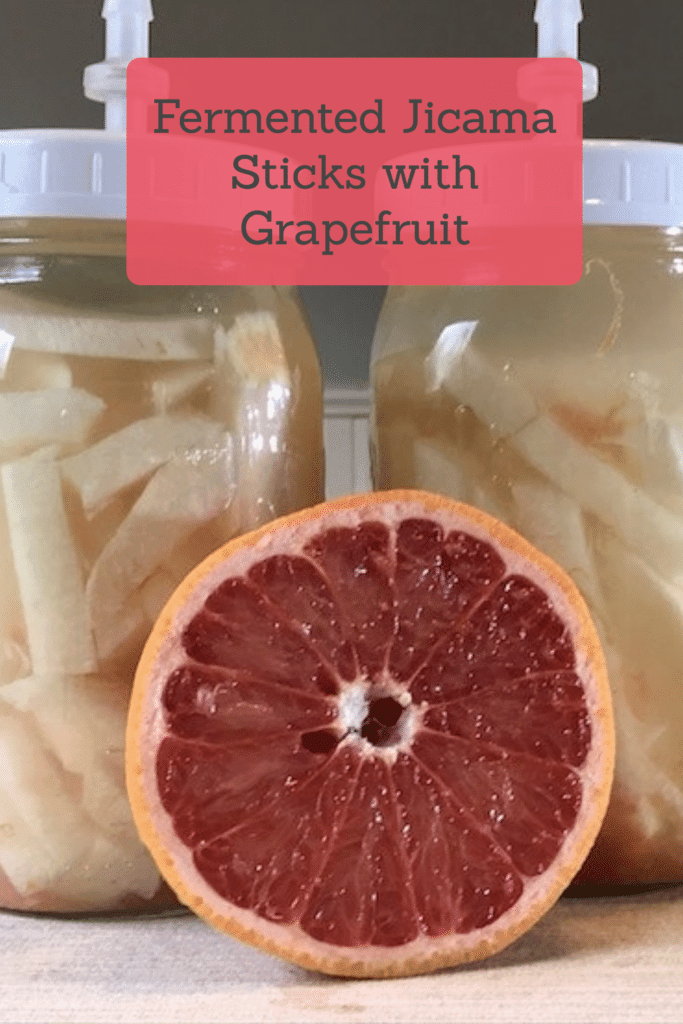
How to make Fermented Jicama Sticks with Grapefruit:
- Place the starter culture in a dish of cool filtered water. (Follow the directions on your specific package.)
- Peel and cut the jicama into sticks (about finger width).
- Put the salt in a bit of warm water to dissolve.
- Zest and juice the grapefruit.
- Add the starter culture, juice, and zest to your clean mason jar.
- Pour the salt water over the top. Add more filtered water if needed to make sure the jicama is completely covered, but leave an inch or so at the top to allow for expansion.
- Place your fermentation weight on top of your jicama to keep them under the brine and then your fermenting lids on top.
- Let the jicama sit in a dark place for 3 days and up toa week. (Test to find when it is fermented to your liking.)
- Transfer to the fridge to slow the fermentation process. These will easily keep in the fridge for 6 months or more, but I highly doubt they will last that long! Feel free to change up the recipe and replace the grapefruit with orange, lemon, or lime.
Fermented Jicama with Grapefruit
Ingredients
- 2 pounds of jicama peeled and cut into finger-width sticks
- Zest and juice from one grapefruit
- Starter Culture 1/2 packet if using Cutting Edge Cultures (or 2 T starter brine or whey)
- 2 teaspoons Celtic Sea Salt
Instructions
- Place the starter culture in a dish of cool filtered water. (Follow the amounts/directions on your specific package.)
- Dissolve the Celtic sea salt in a bit of warm, filtered water.
- Add the starter culture, juice, and zest to your clean mason jar.
- Place your jicama sticks in the jar vertically, getting as many in as possible.
- Pour the salt water over the top. Add more water if needed to make sure the jicama is completely covered, but leave an inch or so at the top to allow for expansion.
- Place your fermenting weight on top of the jicama and top the jar with your fermentation lid.
- Let the jicama sit in a dark place for 3 days and up to a week. (Test to find when it is fermented to your liking.)
- Transfer to the fridge to slow the fermentation process.
- These will easily keep in the fridge for 6 months or more.
Notes
Have you ever fermented jicama? What did you think? What are your favorite fermented foods? I’d love to hear from you!
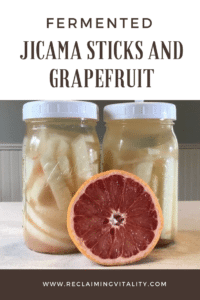

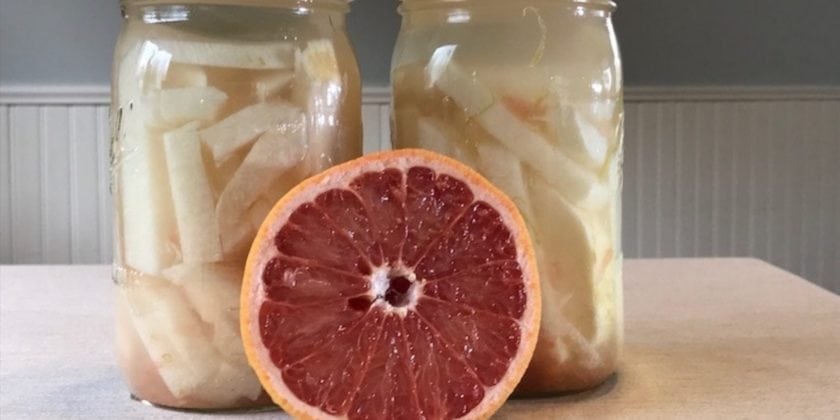
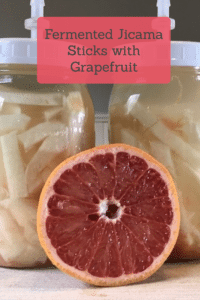
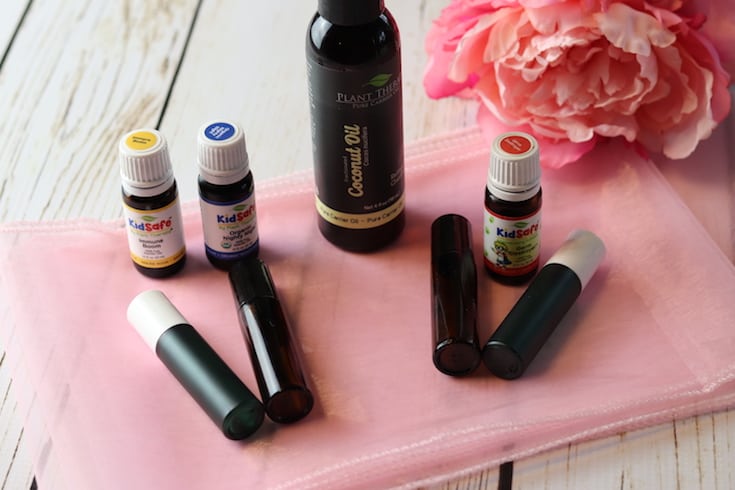

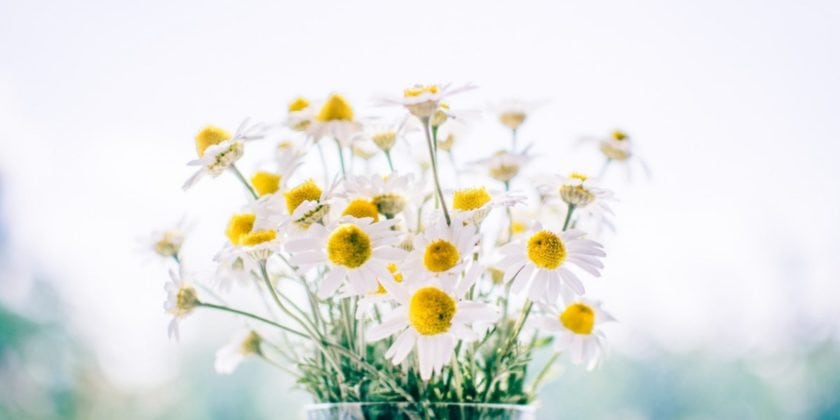
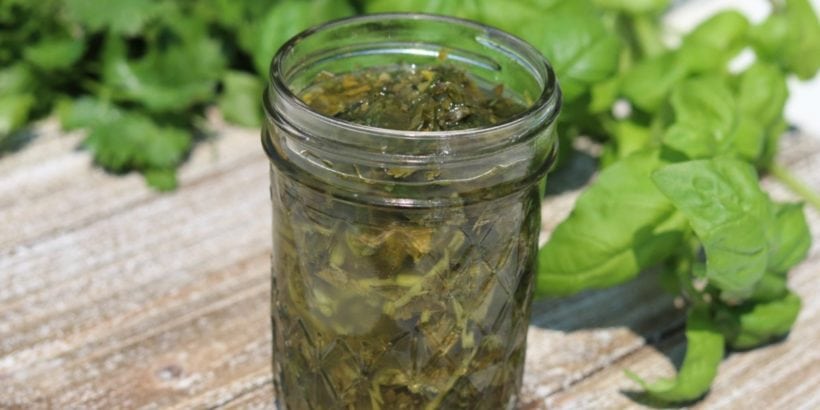




I might need to taste yours. I’ve never been a huge fan of jicama but this is very intriguing especially from the health benefits! Maybe our next play date you should bring snack 🙂 Loving your blog!!!
So glad you are loving the blog! Yes, I will bring snack at next play date 🙂
Have you ever tried Mercola’s culture starter on Amazon? It seems more economical. Would that work?
Actually, yes! I bought it a couple of months ago. What sold me on it are the particular probiotic strains that are proven to be able to colonize the gut. I haven’t created any recipes with it yet, though. His directions include using celery juice instead of a sea salt brine (salt/water mixture), and I wasn’t a fan. I will be doing some experimenting with getting the perfect brine ratio for his starter and be posting more recipes. 🙂
Sorry to ask another question. I have fluffy kosher sea salt. Would I use the same amount?
No worries! Questions are great! The Celtic salt that I use is pretty fluffy, so I think the same amount should be perfect. Have fun!!
Thank you for this recipe, Chelsea! My first try was very successful and I enjoyed the results, but two subsequent attempts have turned alcoholic.The culture company says “avoid fruit,” but I had this happen with some vegetable cultures too that had no fruit in them, plus why did this work the first time? I don’t have fermentation lids, but had several successful fermentations with kimchee, cauliflower, broccoli, etc before the alcoholization began. Was using the cultures with my successful first tries, ran out and just used salt; that’s when the alcohol issue arose. So I’ve started with cultures again; this latest failure with the jicama was with cultures. . . thanks for any ideas you might have!
Hi Jane! I don’t think the lack of fermentation lids is causing the problem. I think it could be related to a higher room temperature causing the jicama to ferment too quickly. Is the place where you are sitting your ferments warmer than it was that first time (ie near the oven/stove)? Or have you moved them? Also, how long did you let them ferment? I would try moving them to a place that is a little bit cooler (and out of direct sunlight, of course). I would also try your ferments after just a couple of days to see how they are tasting. There are so many variables with ferments, which is one of the nice things about using the cultures because at least that part is predictable. 🙂 I have never had the alcohol problem with this recipe, but every now and then the jicama get soft before we finish them (this usually means more salt is needed). Hopefully this is helpful. Please let me know if room temperature is a possible cause and how the next attempt goes! I wish you luck!
Thank you, Chelsea — this is helpful. My fermenting cupboard is right next to the stove, and I wasn’t doing it there at first when I had my successes! Also, have realized I’ve been adding a bit of sucanat to the starter — have seen recipes that included it and because the culture directions said to add “Ecobloom” it sounded like the cultures needed a boost beyond warm water. These two products aren’t sold together, and I hadn’t been aware it was necessary until I’m there in the middle of the operation. Anyway, I’m quitting with the sugar and moving the operation. Will report back! Many thanks! — J
Hi Jane,
So glad to hear that was helpful. Looking forward to hearing how it goes!
Chelsea
I made the fermented jicama but it Tate bitter, I fallow the recipe, is that normal?
Hi Edith,
Was the grapefruit fresh? If the grapefruit was bitter instead of fresh, that may be what went wrong. Another possibility is that it fermented for too long. Did you taste test along the way? A third possibility is that when you zested the grapefruit you got too much of the white pith which is bitter. You want to get just the top of the peel when zesting and avoid the pith as much as possible. I hope this helps with your troubleshooting!
Chelsea
link to fermentation lids is broken
Thanks, Roger! 🙂
Hi Chelsea,
Can the brine from the jicama be reused? I only used salt, no starter, if that might make a difference….thanks!
Hi Lisa,
Yes, you can use a bit of your old brine as a “starter” for new brine to get the fermenting started off more quickly. You will still need more water and salt though.
Chelsea
Can you use other citrus fruits? my daughter is on blood thinners and can’t eat grapefruit.
Absolutely! It is great with oranges instead! I’ve never tried lemon or lime though. They might be too tart.